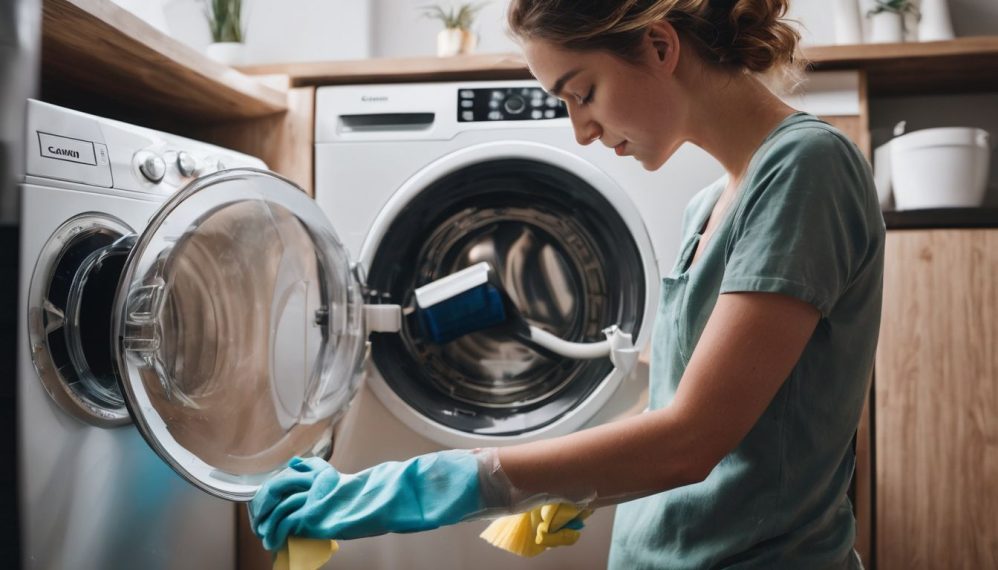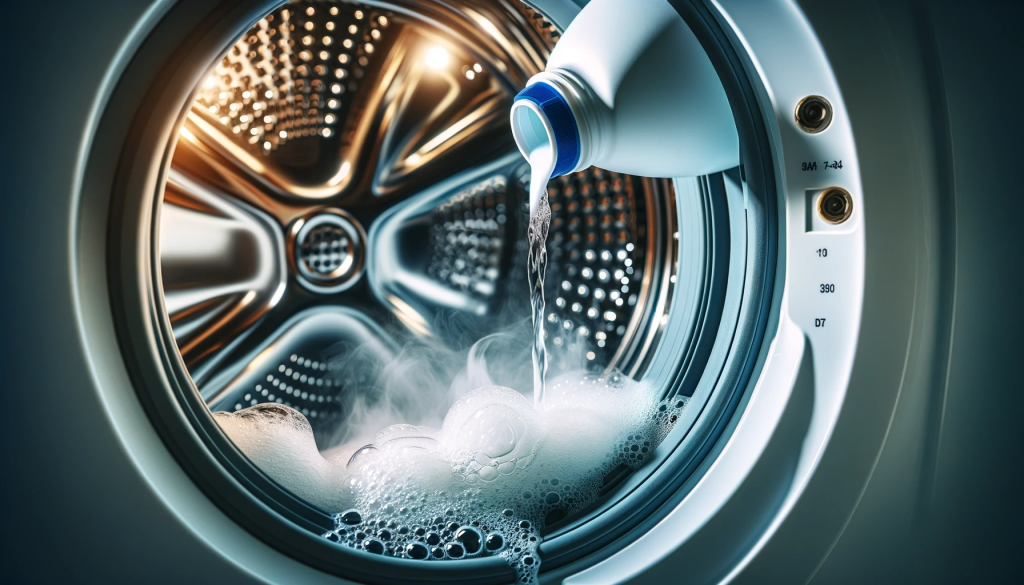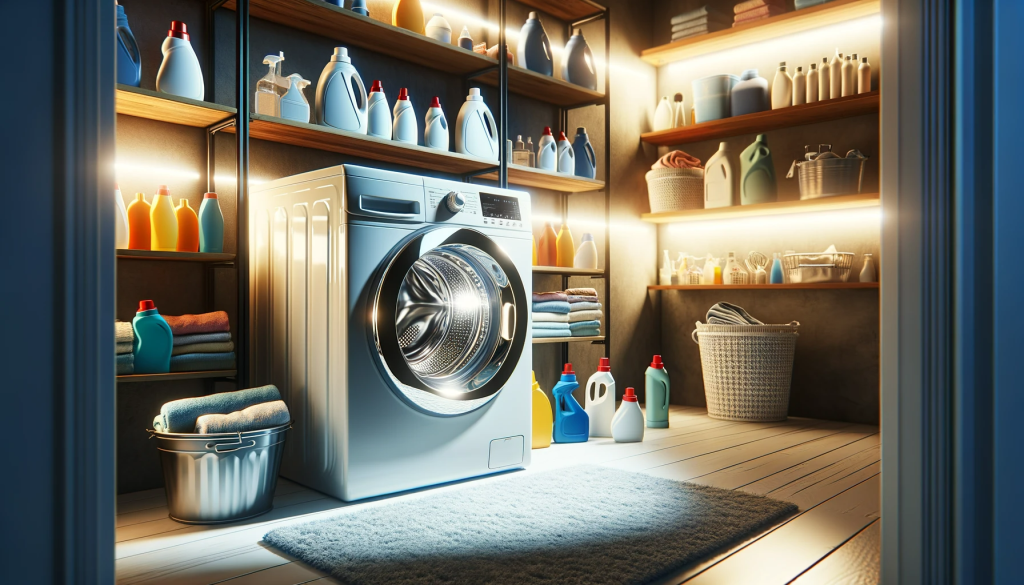
Has your laundry lost that fresh scent, hinting that it’s time to clean the machine itself? A neglected washer can harbor unwanted odors and reduce cleaning effectiveness. Our guide takes you through a foolproof, step-by-step process on how to clean your washing machine, to banish grime and ensure your clothes come out spotless every time.
Keep reading for a cleaner wash day!
Key Takeaways
- Use a combination of white vinegar and baking soda to naturally clean your washing machine; pour half a cup of baking soda into the drum followed by two cups of vinegar in the detergent dispenser, then run a hot wash cycle.
- For stubborn grime and odors, consider commercial washing machine cleaners. These are specifically formulated to target soap scum and mineral build-up within your appliance.
- Clean all parts of the washing machine including interior surfaces, agitators, filters, and hard-to-reach nooks using tools like brushes or old toothbrushes as well as cloths for wiping down damp areas after use.
- Keep up with regular maintenance such as drying out the drum and door gasket after each use to prevent mold growth; only use recommended detergent amounts to avoid excess buildup that can affect performance.
- Run an empty hot wash cycle at least once a month with either your homemade vinegar solution or a store-bought cleaner to ensure optimal efficiency and cleanliness for every laundry session.
Why It’s Important to Clean Your Washing Machine Regularly
Keeping your washing machine in tip-top shape isn’t just about aesthetics; it’s a crucial step to ensure your clothes come out sparkling clean every time. By giving this hardworking appliance the TLC it deserves, you’re not only saying goodbye to unseen grime but also boosting its efficiency for laundry days ahead.
Eliminates Bacteria and Mold
Cleaning your washing machine tackles the unseen culprits that can cause a stinky mess: bacteria and mold. These unwanted guests thrive in damp environments like a washer tub, breeding after each cycle if leftover moisture lingers.
A thorough cleanse strips away mildew and germs, leaving you with a sanitized drum where fresh laundry can spin without picking up any foul odors or irritating allergens.
Regular maintenance not only banishes these microbes but also prevents their comeback by disrupting cozy conditions they love. Scrubbing down detergent dispensers, wiping the gasket, and airing out the drum are simple habits that keep your appliance in top shape.
Your clothes come out cleaner because they’re washed in an environment free of contaminants—ensuring every laundry day ends with truly clean results.
Removes Dirt and Oil Buildup
Over time, washing machines can accumulate a mixture of dirt and oil from our clothes. This buildup not only leaves a residue inside the washer tub but can also affect performance, often trapping odors that transfer to your laundry.
Regular cleaning breaks down these layers, ensuring that each load emerges truly clean and smelling fresh.
Using the right methods to tackle this grime maintains the efficiency of your machine and extends its lifespan. Start by selecting either home remedies like vinegar or commercial cleaners designed for washer upkeep.
After addressing dirt and oil buildup, focus on keeping your clothes’ freshness by moving to the next step: ensuring effective cleaning during every wash cycle.
Ensure Efficient and Effective Cleaning of Clothes
To ensure efficient and effective cleaning of clothes, keeping your washing machine in top shape is crucial. Dirt, soap scum, and mineral deposits can accumulate inside the washer tub over time, causing a less than optimal wash cycle and leaving residues on your laundry.
Regularly running a maintenance wash with hot water and a specialized cleaner can help dissolve these accumulations.
Cleaning out detergent dispensers is also an essential step for fresh laundry. Residual detergents or fabric softeners in these trays invite mold growth that could stain or give unpleasant odors to your clothing.
By taking care of the components where you add cleaning agents, you’re not only promoting better hygiene but also enhancing the effectiveness of each cycle your appliance runs.
Common Methods for Cleaning a Washing Machine
When it comes to giving your washing machine a thorough cleanse, there’s more than one way to get the job done. Whether you prefer natural solutions like vinegar and baking soda or opt for specially formulated commercial cleaners, each method serves to deodorize and sanitize, setting the stage for laundry that comes out as impeccably clean as the washer itself.
Vinegar and Baking Soda
Vinegar and baking soda make a powerful duo for tackling grime and odors in your washing machine. Pour half a cup of baking soda directly into the washer drum to scour away stuck-on dirt without scratching the surface.
Follow this by adding two cups of white vinegar to the detergent dispenser, initiating a hot wash cycle that will break down buildups and banish musty smells.
As the machine agitates, these natural cleaners work together to foam up and reach every nook and cranny. The combination not only cleans but also sanitizes, leaving behind a clean washer ready for more fresh laundry.
This method is safe for regular use, ensuring efficient laundry every time without resorting to harsh chemicals.
Commercial Washing Machine Cleaners
Commercial washing machine cleaners are a powerful ally in your laundry routine. These specialized products work by breaking down the gunk and grime that accumulates in hard-to-see places inside your machine.
They come formulated with ingredients designed to target soap scum, leftover detergent, and lime or mineral build-up that cause unpleasant odors over time. Using these cleaners is easy: simply follow the instructions on the packaging, usually adding the cleaner directly into the drum of an empty washer and running a hot water cycle.
Switching between DIY cleaning solutions like vinegar and baking soda to commercial options can give you professional-level results right at home. Most brands offer cleaners compatible with both front load washing machines and top loader models, ensuring you get a deep clean no matter what type of appliance you have.
Keep your appliance maintenance up to par by incorporating one of these robust cleansers into your monthly washing machine care regimen, so every load of laundry comes out smelling fresh and feeling efficient without any extra hassle.
How to Clean a Washing Machine: Step-by-Step Guide
Dive into the nitty-gritty of refreshing your washing machine with our comprehensive step-by-step guide; we’ll walk you through everything from running that first hot cycle to tackling those sneaky nooks and crannies.
Get ready to transform your laundry routine with a washer that works like it’s brand new, ensuring every load emerges impeccably clean and smelling great.
Gather Necessary Materials and Equipment
Before tackling the grime and residue in your washing machine, make sure you have everything ready. You’ll need white vinegar or a commercial washer cleaner, baking soda, a microfiber cloth, an old toothbrush for scrubbing nooks and crannies, and rubber gloves to protect your hands.
These items will help ensure that every part of your laundry machine gets a thorough cleaning.
Assemble all the tools and cleaners near your washing machine before starting. This includes measuring cups for precise ingredient use, especially if you’re mixing up a DIY concoction.
Having all materials at hand streamlines the process and prevents any mid-clean disruptions that might arise from searching for forgotten supplies. Now with preparations complete, you’re set to begin transforming your appliance back into the efficient laundry marvel it’s meant to be!
Run a Hot Cycle with Vinegar or Washer Cleaner
Starting the cleaning process for your washing machine with a hot cycle can effectively remove grime and odors. Either vinegar or a commercial washer cleaner will do the trick to ensure fresh laundry.
- Select white vinegar or choose a specialized washing machine cleaner from the store.
- Fill the washer drum with hot water if your machine has a manual setting, or select the hottest cycle available.
- Add two cups of white vinegar directly into the drum if you’re going for a natural clean.
- For those using a commercial cleaner, follow the instructions on the package for how much to use.
- Close the lid or door and start the washing cycle.
- Allow the cycle to run completely without interrupting it, ensuring all residue dissolves.
- The heat combined with vinegar’s acidic properties or the cleaning agents in commercial products helps to break down buildup inside your appliance.
Clean the Interior of the Machine
Cleaning the interior of your washing machine is crucial for preventing unpleasant odors and ensuring your clothes come out sparkling clean. Here’s a straightforward process to tackle this task:
- Empty the washer tub completely before cleaning.
- Select the hottest water setting available on your machine for optimal cleaning power.
- Add two cups of white vinegar to the detergent dispenser to break down grime without harsh chemicals.
- Run a full cycle with just the vinegar to loosen any mineral deposits and mold.
- Immediately after the cycle ends, sprinkle half a cup of baking soda directly into the drum.
- Run another hot water cycle with the baking soda to scrub away lingering odors and stains.
- Pause midway through this second cycle, allowing the water, vinegar, and baking soda mixture to sit for 30 minutes. This soak helps in deep cleaning.
- Finish running the full cycle so that all cleaning agents thoroughly rinse away.
- After cycles are complete, use a clean cloth or sponge dampened with warm water to wipe inside the drum.
- Pay attention to areas around rubber seals or gaskets where residue might accumulate.
- Gently scrub any visible spots or stains using a soft brush or an old toothbrush for precise cleaning action.
Clean the Agitator and Filter
Keeping the agitator and filter of your washing machine clean is crucial for maintaining its performance. Dirt, fabric lint, and other debris can accumulate over time, causing a less efficient wash cycle.
- Begin by removing any items from the washer tub. Make sure the drum is empty before you start.
- Lift out the agitator if it’s detachable. Most top – loading machines will allow you to do this.
- Soak it in hot water mixed with a small amount of detergent for 15 minutes to loosen grime.
- Use a soft brush to scrub off lingering dirt on the agitator’s surface and crevices.
- Rinse thoroughly with clean water until all soap residue is gone.
- Inspect the filter, located usually at the bottom or along the top rim of the drum, depending on your machine model.
- Carefully remove any trapped lint or objects from the filter mesh or cavity using tweezers or a soft cloth.
- If your model has a removable lint trap, take it out and wash it under running water.
- After cleaning both parts, let them air dry completely before reassembling them into your washing machine.
Scrub Hard-to-Reach Spots
After tackling the agitator and filter, it’s time to focus on those tricky areas that often get overlooked. Here’s how to scrub the hard-to-reach spots in your washing machine for a thorough clean.
- First, arm yourself with a small, soft – bristle brush or an old toothbrush. These tools are perfect for getting into crevices.
- Aim at the inside of the drum, targeting the rubber seals where gunk can hide. Gently scrub along these seals to dislodge any trapped dirt.
- Look under and around the lid or door area. Dirt accumulates here, so apply some elbow grease.
- Address detergent trays and fabric softener dispensers next. Remove them if possible, and brush away residue.
- Don’t ignore small openings like holes in the drum; use cotton swabs dipped in cleaner to remove buildup.
- Inspect all hoses accessible from inside your washer––squeeze out water that might stagnate there. This prevents mold from growing.
- For top loader washing machines with a fabric softener dispenser at the top of the agitator, pop this piece off and clean thoroughly underneath.
- In front – loading models, take special care cleaning around the glass door; this is where moisture tends to collect.
Clean the Exterior of The Machine
Keeping the outside of your washing machine clean is just as essential as maintaining the inside. A spotless exterior prevents dust and grime from entering the machine, keeping your appliance looking good and functioning smoothly.
- Begin by wiping down the machine’s surface with a damp cloth to remove dust and loose dirt.
- Mix a small amount of mild detergent in a bowl of warm water to create a cleaning solution.
- Dip a soft sponge or microfiber cloth into the solution and gently scrub the exterior surfaces, including knobs and buttons.
- Pay special attention to areas where detergent or fabric softener may have spilled over; these spots may need extra scrubbing.
- If any residue remains around the detergent trays, use an old toothbrush dipped in the soapy water to reach these tighter spaces.
- Dry off all surfaces with a clean towel immediately after washing to prevent streaks and water spots.
- Inspect the area behind and beneath the machine for any lint or debris that could hinder performance; carefully vacuum if necessary.
Run a Second Hot Cycle
Running a second hot cycle acts as the final rinse for your washing machine. This step ensures all cleaning agents and loosened grime are thoroughly washed away.
- Choose the hottest water setting to maximize cleaning power.
- Don’t add any clothes or detergents to this cycle; keep it clear.
- Allow the washing machine to fill with hot water as usual.
- Close the lid or door and let the washer run through a complete cycle.
- Inspect the inside once finished, looking for any residue or suds left behind.
- If you see leftover bubbles or film, run an additional quick rinse cycle without adding anything.
- After completion, leave the door open to air dry and prevent mold growth.
Tips for Cleaning Top-Loading and Front-Loading Machines
Whether you’re tackling a top-loader or a front-loader, each type has its own quirks that require special attention during cleaning. I’ll give you the lowdown on how to address those unique needs and keep your machine running smoothly for both types of washers.
Special Considerations for Each Type of Machine
For top-loading washing machines, pay close attention to the agitator. Dirt and residue often hide in its crevices. Scrub this area well to prevent grime from sticking to your fresh laundry.
Front loaders need extra care around the door gasket; water tends to pool here, which can lead to mold if not dried out properly after each wash cycle.
Ensuring efficient laundry involves cleaning the detergent dispenser regularly as it can clog with undissolved products leading to less effective cycles. Next up, let’s dive into how you can keep that gasket free from mold and ensure your machine runs at its best for years to come.
Clean the Gasket and Prevent Mold and Mildew
Keep the rubber gasket on your front load washing machine in top shape by giving it a thorough wipe down after each wash cycle. Mold and mildew love to grow in the moist folds of the gasket, but you can stop them in their tracks.
Simply use a mix of warm water and mild soap or a sprinkle of baking soda to gently scrub any residue away. Make sure to pull back the folds and get into every nook and cranny.
To keep mold at bay, leave the washing machine door open between uses so air can circulate. This helps dry out any lingering moisture that could lead to mold growth. For an extra layer of protection, consider wiping the gasket with a gentle bleach solution once a month if your manufacturer approves.
Preventing mold and maintaining cleanliness safeguards both your appliance’s efficiency and your laundry room’s hygiene.
Best Products for Cleaning
To get your washing machine sparkling clean and smelling fresh, a good start is to use specially formulated washing machine cleaners. These products are designed to cut through the grime that builds up over time from detergents and fabric softeners.
They’re easy to use; just drop one into an empty washer and run a hot cycle. Brands like Affresh or OxiClean Washing Machine Cleaner have rave reviews for their effectiveness in tackling odors and gunk.
Another top choice for maintaining a clean laundry machine is distilled white vinegar paired with baking soda—an eco-friendly cleaning duo that’s tough on soap scum and mineral deposits but gentle enough not to damage your appliance’s delicate parts.
Sprinkle half a cup of baking soda directly into the drum, then pour two cups of vinegar into the detergent dispenser. Start a hot wash cycle, pause it halfway to let the mixture soak for an hour before completing it.
This natural solution will help dissolve buildup and neutralize any lingering smells without using harsh chemicals.
DIY Washing Machine Cleaner
Creating your own washing machine cleaner is simple and effective. Mix together two cups of white vinegar, a quarter-cup of baking soda, and a quarter-cup of water. This homemade solution works wonders for wiping out bacteria and preventing detergent buildup.
Just pour it into the washer drum and run a hot wash cycle to help maintain your appliance’s efficiency.
For an added boost, sprinkle some baking soda directly into the drum before you start the cycle. The abrasive action helps scrub away stubborn grime without damaging your machine. Use this DIY method every month to keep your laundry smelling fresh and ensure that each load comes out spotless.
How to Clean Specific Parts of the Machine
For the washer tub, start by filling it with hot water and adding a quart of chlorine bleach. Let this mixture sit for an hour; then, enable the machine to run through its longest wash and spin cycle.
Immediately following this, repeat the process using one quart of white vinegar to help dissolve any leftover buildup and deodorize your washing machine. This will leave your washer tub clean, fresh, and ready for laundry.
Moving on to the detergent dispenser, which can get clogged with remnants of laundry products or even mold if not cleaned regularly. Remove it carefully from its housing; most are designed for easy removal.
Soak it in warm soapy water or vinegar solution before scrubbing gently with an old toothbrush or sponge to remove residue. Rinse thoroughly under running water before replacing it back into its slot—this ensures your detergent is dispensed correctly during wash cycles.
Tips and Tricks for Maintaining a Clean Washing Machine
Keeping your washing machine in tip-top shape doesn’t end with just a single cleaning—it requires consistent care and mindful practices. Let’s dive into some savvy strategies to maintain that sparkling cleanliness and efficiency between deep cleans, ensuring every load of laundry comes out fresh and clean.
Regularly Clean and Dry the Drum and Door Gasket
To maintain a fresh laundry experience, make sure you regularly clean the drum of your washing machine. Dirt and detergent can accumulate here, leading to unpleasant odors and potentially impacting the efficiency of your washer.
Use a soft cloth or sponge with mild detergent to wipe down the inside surface of the drum. After cleaning, dry it thoroughly with a clean towel to prevent any moisture from lingering.
The door gasket is another critical area that needs attention, especially in front load washing machines where mold and mildew tend to gather. Pull back the rubber seal gently and inspect for signs of buildup.
Scrub this area using a mixture of warm water and vinegar or a specialized cleaning solution designed for appliances like washers. Once scrubbed, make sure you rinse well and dry completely to keep your machine hygienic and ready for the next load of laundry.
Use Only Recommended Products
Always check your washing machine manual to see which cleaning products the manufacturer approves. Using the wrong type of cleaner can harm the machine’s internal parts, leading to costly repairs or a decrease in its efficiency.
Stick with recommended brands and formulas designed specifically for washing machines. These are formulated to dissolve residue without damaging sensitive components.
Opting for suitable cleaners ensures that every cycle leaves your clothes fresh and clean while maintaining your appliance’s peak performance. Next, let’s tackle how to avoid overloading which can strain your washer and affect cleanliness.
Avoid Overloading
Stuffing your washing machine to the brim might seem like a great time-saver, but it actually hampers the machine’s ability to clean your clothes effectively. Overloading puts extra stress on the washer’s motor and can lead to premature wear or even cause it to break down.
Make sure you fill the drum only up to three-quarters full; this allows clothes room to tumble freely, ensuring a thorough wash and efficient laundry. Not overloading also ensures there is enough space for water and detergent to circulate properly, cutting down on bacteria and mold growth in both top loader and front load washing machines.
Keeping loads manageable protects the mechanics of your appliance while providing fresher laundry with each cycle. It prevents damage not just internally but maintains cleanliness by allowing better dissolution of detergent during a wash cycle.
This keeps both your washing machine maintenance on point and prolongs its lifespan, offering consistently clean results without overworking the system. Regularly check that you’re distributing garments evenly too—this balance is key in reducing strain on spinning components within top-loading or front-loading machines.
Clean the Detergent Trays and Filter Regularly
Keeping your detergent trays spick and span is key to laundry hygiene. Dirt, soap scum, and leftover detergent can clog up these areas, causing your washer to work harder and your clothes to come out less clean.
Pull out the trays every few weeks, give them a good scrub with hot soapy water or a mix of vinegar and water for extra freshness. This will help prevent buildup that can hamper your washing machine’s performance.
Your machine’s filter also needs regular attention—it traps threads, lint, and small objects that could otherwise cause blockages in the system. Locate the filter according to your washer’s manual—often found at the front bottom corner behind a small hatch or within the agitator of top loaders—and clear it out.
Run it under hot water until it’s clear of debris. Doing this monthly will keep things running smoothly and extend the life of your appliance.
Next up: Tips on wiping down the exterior regularly for maintaining overall cleanliness.
Wipe Down the Exterior Regularly
Your washing machine works hard to keep your clothes clean, but don’t forget about its outside! Dust, splatters, and grime can collect on the surface. Use a damp cloth with mild soap to easily swipe away any dirt from the exterior.
This simple step keeps your appliance looking as good as it performs.
Keep an eye out for spills and stains on the control panel too. Quick attention to these little messes helps prevent buttons from becoming sticky or unresponsive over time. Make wiping down the whole machine part of your laundry routine for a sparkling clean laundry room.
Consider using a washing machine cleaner regularly
Using a washing machine cleaner regularly can make a big difference in your laundry routine. These specialized cleaners are designed to power through residue that typical detergents might miss.
They tackle grime, bacteria, and odors lurking within the nooks and crannies of your appliance. Implementing this step helps ensure that every load emerges as fresh and clean as possible.
Machine-specific products often come with easy-to-follow instructions tailored for both front-loading and top-loading machines, making the maintenance hassle-free. Opt for a regular cleaning schedule; utilizing these cleaning agents monthly supports optimal performance of your washer and extends its lifespan, guaranteeing efficient laundry outcomes consistently.
Conclusion
Keeping your washing machine spick-and-span isn’t just about looking good—it’s about performance too. When you take the time to clean, you’re giving your appliance the love it needs to keep those clothes coming out spotless.
Remember that a little effort goes a long way in maintaining efficiency and hygiene. Embrace these cleaning habits, and laundry day will always bring the joy of fresh, clean clothes without any hiccups along the way.
Let’s make every spin cycle count!
FAQs
1. How do I know if my washing machine needs cleaning?
If your washing machine has a musty smell or leaves residue on clothes, it’s time to clean it.
2. How often should I clean my washing machine?
You should aim to clean your washing machine about once a month to keep it fresh and efficient.
3. Can I use household items to clean my washing machine?
Yes, you can use household items like vinegar and baking soda to help clean and freshen up your washing machine.
4. What is the first step in cleaning a washing machine?
The first step is usually running an empty hot water cycle with some cleaning solution or vinegar to loosen up any grime.
5. Is there anything special I need to do after cleaning the inside of my washer?
After cleaning, leave the door open for a while so the drum can air out and dry completely.



